Random Reviews: V for Vendetta
Alan Moore and David Lloyd's seminal work is an experiment in destruction and chaos, poetically paving a path for others to rebuild
—by Nathan on August 3, 2025—
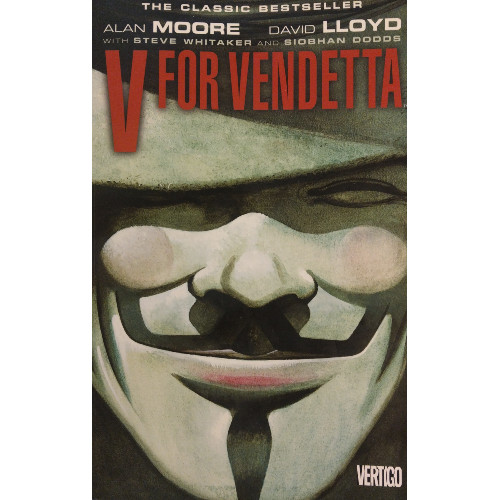
"A" is for "Alan Moore," who created this narrative with David Lloyd.
"B" is for "Britain," where our story takes place and where V for Vendetta was originally published, as a black-and-white serial in the anthology series Warrior.
"C" is for "Can we get on with the review already?"
Sure, sure. Sorry. I was going to run through the entire alphabet, but if you insist...
The above statements are true. V for Vendetta was initially published in a serialized format in Warrior before being published by DC Comics as a colorized, ten-issue limited series. DC has since published the full narrative in collected editions under both their Vertigo and Black Label banners. It is the Vertigo edition I picked up and read (and, in this instance, re-read) for this review.
Author Alan Moore needs little introduction. I've already reviewed Watchmen, the opening chapters of his Swamp Thing run, and his Superman stories "Whatever Happened to the Man of Tomorrow?" and "For the Man Who Has Everything." I've appreciated the Moore work I have read thus far and wanted to examine another classic narrative of his. As with my Watchmen review, I will note than I understand the legacy of V for Vendetta and the reams of digital paper already given to exploring its depths. I am not competing with any of those reviews, nor am I looking to contribute the most detailed examination to the abundance of opinions already on the narrative. I'm looking to dive in as deep as I would like to go, explore the world for a little while, and see if maybe someone will walk away from this review with a mind to take a look themselves.
In other words: please visit and value these virtual viewpoints but do not venture to validate my vanity through voluntary veneration.
V for Vendetta
Writer: Alan Moore
Penciler: David Lloyd
Inker: David Lloyd
Colorists: David Lloyd, Steve Whitaker, and Siobhan Dodds
Letterers: Jenny O'Connor, Steve Craddock, and Elitta Fell
Issues: Warrior #1-16, #18-19, #21-26 (original issue publication); V for Vendetta #1-10 (reprints)
Volume Publication Date: June 2005
Issue Publication Dates: March 1982-April 1982, July 1982, September 1982-January 1983, April 1983, July 1983-December 1983, April 1984, June 1984, August 1984-December 1984, February 1985 (Warrior); September 1988-March 1989, May 1989 (DC Comics)
Publisher: Quality Communications (Warrior installments publisher), DC Comics and Vertigo (DC Comics imprint–comic reprints and collected edition)
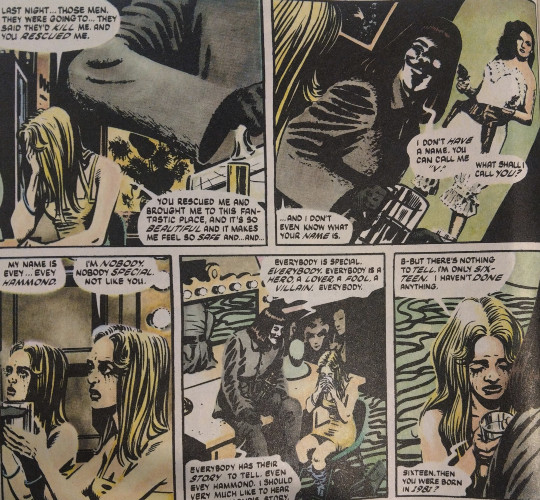
Though begun in Warrior, V for Vendetta halted publication in 1985 when the magazine folded. DC Comics acquired the rights due to, so I've read, Moore's popularity because of his work on Swamp Thing and Watchmen. Republishing the Warrior chapters as the first seven issues in a ten-issue limited series, DC allowed Moore to complete the narrative in the final three issues, bringing V for Vendetta all the way from A to Z.
I've previously mentioned stories I read for a graduate-level thesis I wrote in 2024, including Maus and The Death of Captain Marvel. I intended to include V for Vendetta before remembering its place of origin on the other side of the pond. As I was focusing on comics originally produced in America, I dropped V from my thesis…but I did read it. And because I wanted to put my thoughts on paper, I read it again recently. Did I enjoy it a second time?
In a word? Very.
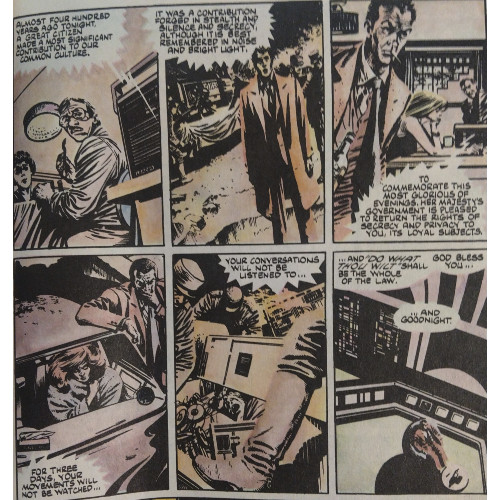
My biggest problem with Moore's other seminal work, Watchmen, was his characters. I finished the series not feeling terribly fond towards anyone in particular. The characters themselves aren't forgettable–certainly not the blue god, nor the masked Rorschach–but I just did not enjoy them. The story was elaborate, Dave Gibbons' art wonderfully peppered with background details and symbolism. The play was great…the acting, not quite as much. In reading V for Vendetta, I found I encountered, not the exact opposite experience, but a tad overturned: I enjoyed the narrative well enough, but it was the characters who spoke to me.
I couldn't begin to fully grasp all the allusions Moore and Lloyd make to pop culture and history in this series, how exactly an opera piece used in one chapter relates to tearing down an oppressive government body or why this particular book pops up at this particular time. I did endeavor to do some research while I read to grasp some of the deeper significances, but as I noted in the intro, I'm not here to parse all those intricacies out. Because you can throw around big words that resemble bigger ideas, but if you don't give me relatable characters to tether those ideas to, you're not going to hold my attention for long.

Moore suffers no such issues. Take V himself, the terrorist in the Guy Fawkes mask. Moore drapes him with a unique complexity–introduced in the first chapter as "the villain," V is a brutal terrorist who bombs statues and buildings, knifes people to death, and tortures both his enemies and at least one seeming ally. Oftentimes logical to the point of coming across as downright cold, V has his peculiar quirks–talking to a statue of Justice as if they had been in a relationship, placing people in elaborate mind games with set dressing some movie studies may envy, and conducting a series of bombings as if he were an orchestra conductor, complete with the stand, baton, and sheet music. Though bombastic in his obsession with a free England, V is also driven by his own intentions–why don't we call it a "vendetta"?–with several murders early in the series part of a revenge plot while also furthering his larger ends. But the vengeance is there.
By calling him "the villain," Moore strips back some of V's complexity when we are introduced to him, a sinister masked figure who murders several men…yet it's all done to save a young woman who becomes his apprentice. Maybe, we think, he's just a villain, a ruffian, in the eyes of the law. But as we come to learn about the law and how monstrous it can be, we're asked to wrestle with V's less-than-humane tactics and wonder about the necessity of them. He is dedicated to his cause and willing to inflict what he believes is the necessary price of freedom upon a totalitarian government to liberate the people living under its iron thumb…but only if they're willing to be liberated.
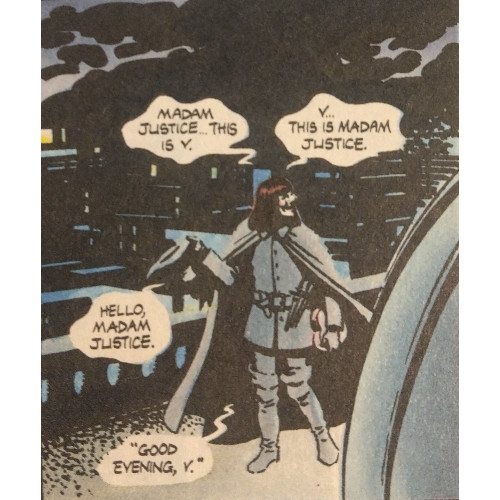
V is, I think rightfully, a vigilante, a man who moves through shadows to work his will about wrongdoers. But he can only take his movement so far; what makes the character brilliant is he understands the limitations of his actions and his influence. He destroys, tearing down what has been built, but he recognizes he cannot rebuild. The one thing he does create, a batch of roses in his "shadow gallery," he leaves on the corpses of his victims, a sign of rebirth but one which must come after him. This is where Evey, his protege, enters the narrative, to become the rebuilder, and this is where society must be left: in the throes of chaos, with the government dismantled, so they can work their own will once the flames and furor of passions have cooled.
We're not told too much of V as a character other than his obsession–we're never given a face or a name–and I believe this is intended so we can latch onto other characters. Ignore the mystery of V and accept his base characteristics: he kills and he blows things up, all in the name of engineering the anarchy which will spell the liberation of England. Embrace Evey Hammond instead, the young woman V rescues and brings in. Initially a young woman in desperate need of a future, Evey believes she finds it with V. Yet her voice should resemble that of ours, as someone who recognizes the engineered chaos permeating the world yet is not fully comfortable with the most destructive methods of dismantling a corrupt regime.
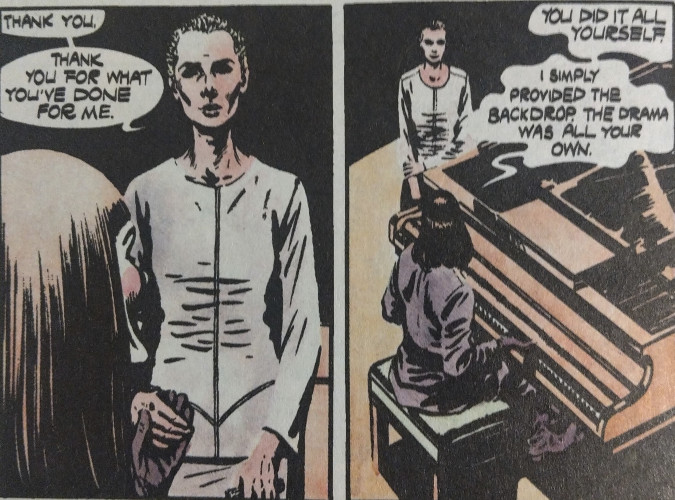
We watch Evey walk through this world of shadows, seeking to find her own place in V's grand scheme yet on her own terms. She tells V she won't kill, a position she reinforces after she inadvertently (to her own knowledge) plays a hand in V murdering a corrupt priest and even after she undergoes horrifying torture midway through the book. When V subtly offers to murder a killer who murdered a paramour of hers, Evey refuses. The torture she experiences leaves her in a position where she more readily embraces V's dream. It removes her fear of pain and death and puts her in a position where she becomes a more willing participant in his endeavors. But again, through her experiences, she becomes more sure of herself as a person, not just an obedient little soldier for the man in the mask.
The rest of the series' most notable characters are all affiliated with the government in charge, the Norsefire Party, in some way, and the most interesting of those notable characters are the individuals who find themselves breaking free from Norsefire's oppression. Mr. Finch, a detective for the Party's "Nose," is consistently depicted as somewhat doubtful, actions pushing him ever forward towards embracing freedom on his own terms the deeper he gets into hunting V down. He doesn't believe V's actions are credible, yet he doesn't fully support Norsefire, finding himself in the strange position where he's willing to serve as a detective but not because the government wants him to. Pursuing and stopping V becomes his own personal vendetta…
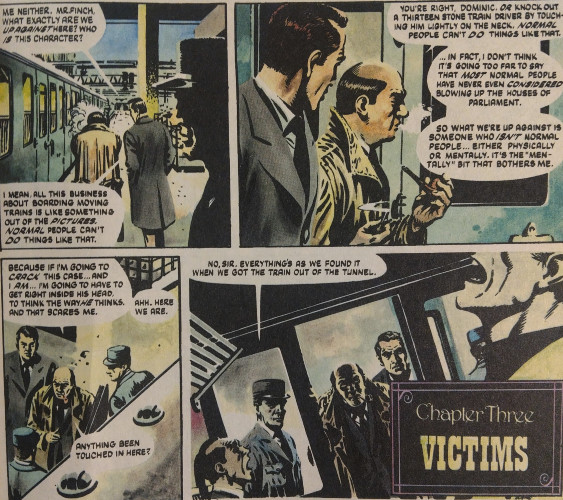
…as does a different, more violent goal become for Rosemary Almond, whose husband is murdered by V. Moore cleverly conceals her intentions throughout much of the narrative, and though pursuing her own vendetta leads to some degrading actions, they culminate in the fulfillment of said vendetta for Rosemary. Interestingly, Rosemary is introduced as a battered spouse, yet her love for her husband is clear, particularly in the long-gestating revenge plot which culminates late in the narrative. Like Finch, Rosemary sees beyond the imagery Norsefire throws in people's faces when her husband is murdered. Her mind cleared, she acts.
Perhaps the most notable character to not turn against the Party is Helen Heyer, wife of the head of the "Eye," who wishes for her husband to assume supreme control of Norsefire. She represents the one female character with political ambitions and the seeming power to make certain movements–contrast this, of course, to Rosemary and Evey, who must find their own ways to act out their independence. She's introduced early enough, but her real machinations coalesce late in the story, a little later than I would have appreciated. I would consider her an underutilized chess piece; there's great potential here, but Moore's story is focused on other people and their fates, so Helen feels like a late addition, even if her ambitions and goals, like Evey and Rosemary, become clearer as the story progresses.
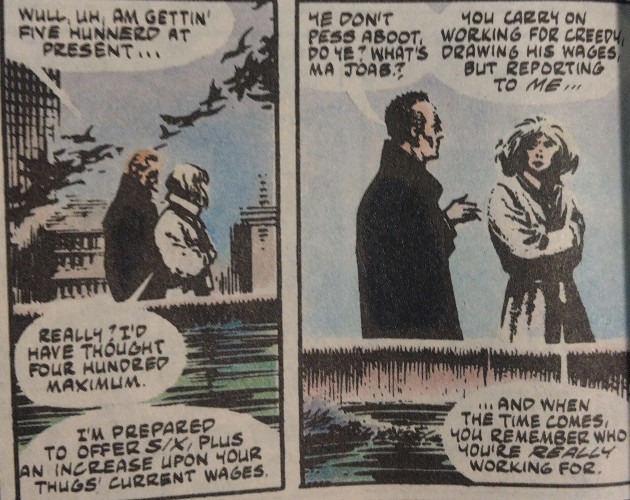
With clarity often comes violence from and for our cast, all built upon the grim foundation Norsefire lays. The structure must be torn down to rubble for a new structure to be built; in the wake of ruin lies a hopeful tomorrow. We don't necessarily see that tomorrow–which, for at least one reviewer I read, is a sore sticking point. Moore can wax poetic on the joys of freedom, yet the London we witness only experiences a taste late in the story, when V temporarily disables Norsefire's surveillance capabilities. Otherwise, that writer felt, we were given an instruction manual with missing final pages. If you tear down a system but don't indicate how to build it again, what's the point? But that isn't Moore's argument. It aligns with the narrative presented–just like Moore ends the narrative before London can make any real progress towards rebuilding, so the reader is left to imagine what could happen in the wake. Moore isn't telling us what to build or how to build. Isn't that the kind of thinking V wants to see overturned? The story is called "V for Vendetta," though vendettas plural play into the series. Once those vendettas are resolved, the tale is concluded.
A scene in the middle of the narrative fits more with the message Moore is providing: breaking into Norsefire's broadcast center, V projects his own pre-recorded message for the masses to hear. In it, V likens society at large (or humanity in general) to an underperforming employee, with himself assuming the role of manager. Essentially outlining in corporate terms mankind's many foibles, V points the finger at the public for bringing London specifically to its current state. Though he concedes the management is "very bad," V attributes a series of tyrants and leaders–flashing images of Joseph Stalin, Adolf Hitler, and Benito Mussolini–to the people for electing these dictators. It's the people who engendered the possibility of corruption, and therefore, once V has played his anarchist bit, it must be the people who make sure weeds don't spring from the rubble in the aftermath.
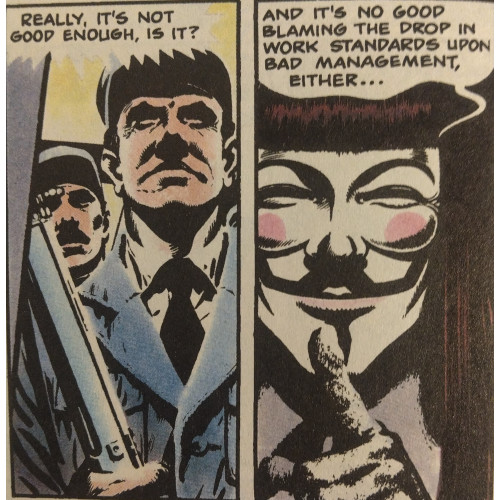
Aside from the characters and compelling political/philosophical dramas, there are just some incredibly clever story beats found in the pages. Two large twists, one with Evey and one with the so-called "Fate computer" Norsefire's supreme leader uses to watch England, are wickedly well-written, timed well and genuinely surprising. The latter can be traced backward a ways, with the discerning reader able to spot clues and perhaps make a guess or two. The former, involving Envy, is devastatingly emotional to the point of cruel, and though it's executed exceedingly well (I got goosebumps during the re-read even though I was aware of the turn), the implications of such dehumanization are brutal to bear.
David Lloyd is the perfect penciler/inker for this narrative. His style is different from Dave Gibbons, who created an immaculately detailed world in Watchmen with some amazing characters yet provided a tinge of the cartoonish to remind us we're reading a superhero comic (even if it's a clever deconstruction of a superhero comic). Lloyd's work feels as close to human as one can get without getting into the "detailed painting" work of someone like Alex Ross. His characters are superbly constructed, and his faces have wrinkles in all the right places to convey the exact emotions he needs to. Other artistic choices aid the storytelling–giving V a cape artistically acknowledges the speed at which he moves in different scenes (more billow = greater speed); Evey's hair at different points–long, shaved, short–visually represents the character's arc as she moves from helpless victim to staunch revolutionary.
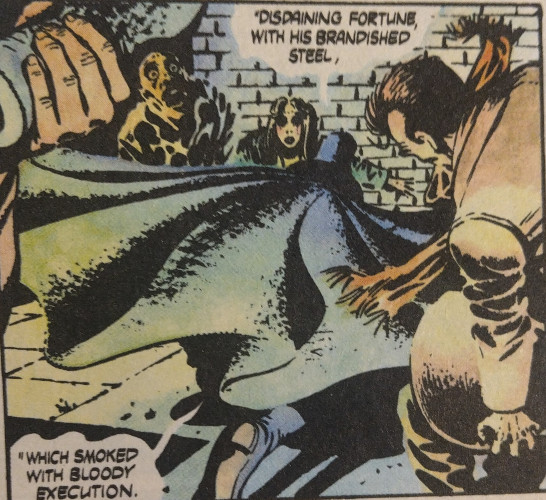
I know I'm not covering everything V for Vendetta has to offer–this is a comic with layers, and if I re-read it again, I'm sure I'll uncover levels I haven't noticed previously. Freedom rings at its core, freedom though some fairly disturbing, disastrous methods. Part of me wants to believe Moore is acknowledging that sometimes the cure may be as bad as the illness, but there is a sense he's a bit more on board (or was when he wrote this narrative) with V. Ultimately, the exact methods the vigilante employs may be a cumbersome distraction, blinding from their true purpose in promising freedom. It's a somewhat nebulous definition Moore provides, or at least, a somewhat uncertain future were that freedom to be obtained. "What do we do now?" you expect characters to ask in the final pages of the narrative. V for Vendetta isn't interested in answering that question. It lays the road, and the road is paved with bodies and blood. We can quibble over whether there's a nicer road out there, maybe one paved with chocolate with happy puppies every few feet or so. But I don't think, realistically, chocolate will overthrow a tyrannical government and stop oppression, nice as that dream would be. And that's not the point with this comic anyway. You may agree with V's methods, you may not. I'm not an anarchist myself, but I think V makes one point clear: you cannot stop at just destruction. It only gets you rubble. Someone may have to throw the switch, but others will need to come in, pick up all the pieces, and see what can be rebuilt in the space provided.